RBSE Class 11 Biology Important Questions Chapter 11 Transport in Plants
Rajasthan Board RBSE Class 11 Biology Important Questions Chapter 11 Transport in Plants Important Questions and Answers.
Rajasthan Board RBSE Solutions for Class 11 Biology in Hindi Medium & English Medium are part of RBSE Solutions for Class 11. Students can also read RBSE Class 11 Biology Important Questions for exam preparation. Students can also go through RBSE Class 11 Biology Notes to understand and remember the concepts easily.
RBSE Class 11 Biology Chapter 11 Important Questions Transport in Plants
Multiple Choice Type Questions
Question 1.
In fully turgid cell, the value will be zero for:
(a) wall pressure
(b) suction pressure
(c) turgor pressure
(d) osmotic pressure
Answer:
(b) suction pressure

Question 2.
Guttation occurs by:
(a) stomata
(b) lenticels
(c)hydathodes
(d) wounds
Answer:
(c)hydathodes
Question 3.
The rate of transpiration is measured by:
(a) potometer
(b) photometer
(c) lactometer
(d) barometer
Answer:
(a) potometer
Question 4.
The theory of ascent of sap was given by:
(a) MC Clung
(b) J.C. Bose
(c) Flamming
(d) Leader Berg
Answer:
(b) J.C. Bose
Question 5.
The principle of ascent of sap given by Dixon and Joly was based on:
(a) cohesion force of water
(b) continuity of water column
(c) transpiration pull
(d) All of these
Answer:
(d) All of these
Question 6.
The maximum absorption of water takes place by:
(a) complete root
(b) secondary root
(c) radicle
(d) root hairs
Answer:
Question 7.
The hypothesis regarding the translocation of organic solutes in plants was given by:
(a) Munch
(b) Kreb
(c) Calvin
(d) Dixon
Answer:
(a) Munch
Question 8.
The function of lenticels is:
(a) guttation
(b) transpiration
(c) absorption
(d) exchange of gases
Answer:
(b) transpiration
Question 9.
What happens when a cell is kept in a solution of higher concentration?
(a) Plasmolysis
(b) Osmosis
(c) Excretion
(d) Evaporation
Answer:
(a) Plasmolysis
Question 10.
For the initiation of plasmolysis in the cell, the salt solution should be:
(a) isotonic
(b) hypertonic
(c) hypotonic
(d) None of these
Answer:
(b) hypertonic

Quesiton 11.
In non - turgid cell, the diffusion pressure deficit is equal to:
(a) OP - WP
(b) OP + WP
(c) TP
(d) OP
Answer:
(a) OP - WP
Quesiton 12.
Transpiration helps in:
(a) flowing
(b) ascent of sap
(c) fruiting
(d) loss of mineral elements
Answer:
(b) ascent of sap
Question 13.
The direction and rate of water movement from one cell to another cell depends on:
(a) diffusion pressure deficit
(b) wall pressure
(c) turgor pressure
(d) incipient plasmolysis
Answer:
(a) diffusion pressure deficit
Question 14.
The atmospheric humidity decreases the rate of:
(a) transpiration
(b) photosynthesis
(c) glycolysis
(d) growth
Answer:
(a) transpiration
Question 15.
The osmotic potential of solution is represented by a sign:
(a) ψx
(b) ∆ψ
(c) ψp
(d) ψs
Answer:
(d) ψs
Question 16.
During opening of stomata the ion that gets accumulated in guard cells is:
(a) Mg
(b) P
(c) K
(d) Ca
Answer:
(c) K
Question 17.
The osmotic expansion of a cell kept in water is chiefly regulated by:
(a) mitochondria
(b) vacuoles
(c) ribosomes
(d) plastids
Answer:
(b) vacuoles
Question 18.
When water moves through a semipermeable membrane, the developed pressure is called:
(a) OP
(b) SP
(c) TP
(d) WP
Answer:
(a) OP

Question 19.
A column of water within xylem vessels of tall trees does not break under its weight because:
(a) lignification of xylem vessels
(b) positive root pressure
(c) dissolved sugar in water
(d) tensile strength of water
Answer:
(d) tensile strength of water
Question 20.
Loss of water from the margins (tips) of the leaves is called:
(a) guttation
(b) transpiration
(c) respiration
(d) evaporation
Answer:
(a) guttation
Question 21.
Most accepted hypothesis for ascent of sap is:
(a) capillary hypothesis
(b) root pressure theory
(c) pulsation theory
(d) transpiration pull theory
Answer:
(d) transpiration pull theory
Question 22.
A cell will get turgid when it is kept in:
(a) hypotonic solution
(b) hypertonic solution
(c) isotonic solution
(d) all of these
Answer:
(a) hypotonic solution
Question 23.
Guard cells help in:
(a) provide grazzing protection
(b) transpiration
(c) guttation
(d) provide infection protection
Answer:
(b) transpiration
Question 24.
Which is removed in ringing experiment?
(a) only bark
(b) bark with phloem
(c) only phloem
(d) all vascular tissue
Answer:
(b) bark with phloem
Question 25.
Which of the following substances, reduces the rate of transpiration?
(a) Phenyl mercuric acetate
(b) Abscisic acid
(c) (a) and (b)
(d) None of these
Answer:
(c) (a) and (b)

Question 26.
The available water in soil is:
(a) capillary water
(b) chemically bounded water
(c) gravitational water
(d) hygroscopic water
Answer:
(a) capillary water
Very Short Answer Type Questions
Question 1.
What is potential of pure water?
Answer:
Zero bars.
Question 2.
At how many levels does transport occur in plants? Write their names.
Answer:
Transport in plants occurs on three levels:
- cellular transport
- short distance transport
- long distance transport.
Question 3.
What is active transport?
Answer:
The transport of substances with the help of carrier and energy is called active transport.
Question 4.
Which apparatus is used to measure root pressure?
Answer:
Monometer.
Question 5.
Name the ion which take part in opening and closing of stomata.
Answer:
Potassium ions (K+).

Question 6.
What is mycorrhiza?
Answer:
The symbiotic relation between the roots of higher plants and Fungi is called mycorrhiza.
Question 7.
Where are Hydathodes found?
Answer:
Hydathods are found on leaf margins in herbaceous plants such as tomato, grasses etc.
Question 8.
Who proposed pulsation theory of ascent of sap?
Answer:
J.C. Bose proposed pulsation theory of ascent of sap.
Question 9.
Why grapes shrink in concentrated salt solution?
Answer:
Due to exosmosis.
Question 10.
Name two plants in which stomata open at night.
Answer:
- Opuntia
- Agave.
Question 11.
Who proposed mass flow hypothesis?
Answer:
Munch proposed mass flow hypothesis.
Question 12.
Name two tissues which take part in transportation in plants.
Answer:
- Xylem and
- Phloem.
Question 13.
What happens when a cell is kept in distilled water?
Answer:
The cell will burst by absorbing more water.
Question 14.
Define diffusion.
Answer:
The movement of molecules or ions of a solid, liquid or gas from the region of their higher concentration to the region of their lower concentration is called diffusion.
Question 15.
What is diffusion pressure?
Answer:
The pressure developed as a result of the diffusing nature of molecules or ions of a substance is called diffusion pressure.
Question 16.
Define Grahm’s law, related to diffusion.
Answer:
The rate of diffusion of any gas is inversely proportional to the square root of its density.
\(R \propto \frac{1}{\sqrt{d}}\)

Question 17.
Define osmosis.
Answer:
A process in which two solutions of different concentrations are separated by a semipermeable membrane. The diffusion of water or solvent molecules takes place from the solution of lower concentration to the solution of higher concentration separated by SPM. It is called osmosis.
Question 18.
Define imbibition.
Answer:
The absorption of water or any other liquid by the solid particle of the substance without forming a solution is called imbibition.
Question 19.
Name two antitranspirant substances.
Answer:
- Phenyl Mercuric acetate
- Abscisic acid (ABA).
Question 20.
Define guttation.
Answer:
The loss of water in the form of droplets from the marginal of leaves is called guttation.
Question 21.
What is the main cause of opening and closing of stomata?
Answer:
The opening and closing of stomata depends upon the turgidity of guard cells.
Question 22.
Who gave the terms diffusion pressure (DP) and diffusion pressure deficit (DPD)?
Answer:
The term diffusion pressure (DP) and diffusion pressure deficit (DPD) were given by B.S. Mayer in 1938.
Question 23.
Give one example of exosmosis.
Answer:
When grapes are placed in concentrated salt solution, they become shrunk due to exosmosis.
Question 24.
Give one example each of artificial semi - permeable membrane and natural semi - permeable membrane.
Answer:
Artificial semipermeable membrane: parchment paper.
Natural semi - permeable membrane: Egg membrane.

Question 25.
What will be the pH of guard cells at the time of stomatal opening?
Answer:
pH 7 to 8.
Short Answer Type Questions - I
Question 1.
The transportation of water and food substances in plants takes place by which tissue? Which tissue show bidirectional flow of substances?
Answer:
The water and minerals are transported from roots to leaves upwardly by xylem tissue. The food synthesized in leaves is transported from them to other parts of plant through phloem tissue. Bidirectional flow of substances takes place through phloem.
Question 2.
What is water potential?
Answer:
Water potential: The difference between the free energy of water molecules in pure water and that of water in any other system (e.g., water in a plant cell or in a solution) is termed as water potential. The concept of water potential was first propounded by Slatyer and Taylor. It is represented by a Greek letter psi (ψ) and commonly represented as ψw and measured by pressure unit pascal.
One megapascal = 10 bars
1 bars = 14.5 lb/n2
= 750 mm Hg = 0.987 atm.
Question 3.
Give the factors which affect imbibition.
Answer:
Factors that affect imbibition are following:
- Imbibition increases with increasing temperature.
- More pH affects imbibition.
- The rate of imbibition decreases at high concentration of solute.
Question 4.
What is the difference between permeability and plasmolysis?
Answer:
The permeability is the feature of cell membrane by which it controls the molecules pass through. While the plasmolysis is a phenomenon in which a cell shrinks when it placed in a hypertonic solution.
Question 5.
Write two significance of osmosis in plants.
Answer:
Significance of osmosis in plants:
- The plants absorb water from soil with the help of root hairs through osmosis.
- In plants, the movement of water from one cell to another takes place by osmosis.
Question 6.
What happens when RBCs are placed in water? Why is it cause so? Name the phenomenon.
Answer:
When red blood cells (RBCs) are placed in water, due to endosmosis, they often burst. Rupture of red blood cells with release of haemoglobin is called haemolysis.

Question 7.
Write two conditions for guttation.
Answer:
Two conditions for guttation are:
- Root pressure: more root pressure, causes more guttation.
- More water absorption but low transpiration.
Question 8.
What do you understand by ascent of sap?
Answer:
The water absorbed by plants is translocated to different parts of the plant. The salt dissolves in water also get translocated along with it. The upward movement of absorbed water against gravitational force to the aerial parts of the plant is called transport of water or ascent of sap, but this water is not pure water, salts are also dissolved in it, hence, it is called ascent of sap.
Question 9.
What is bleeding in plants? Give example.
Answer:
Bleeding: If an incision or wound is made in a stem upto the xylem, the water and xylem sap oozes out. It is called bleeding. The exudation of toddy juice from the palm trees and latex from rubber trees are the best examples of bleeding.
Question 10.
Name any four factors which affect mineral nutrient uptake in plants.
Answer:
Factors which affect mineral nutrient uptake:
- Temperature.
- pH value of soil solution.
- Light.
- Interaction of salts.
Short Answer Type Questions - II
Question 1.
What is permeability? How many types of membranes are there on the basis of permeability? Write the factors affect permeability.
Answer:
Permeability: The permeability is the feature of membranes by which these control molecules pass through. On the basis of permeability the membranes are of four types:
- Impermeable membrane: The molecules of neither solute nor solvent can pass through this type of membrane.
- Semi - permeable membrane: The molecules of only solvent can pass through this type of membrane.
- Selectively permeable membrane: The molecules of solvent and some special or selective substances (solutes) can pass through this type of membrane.
- Permeable membrane: The molecules of both solutes and solvent can pass through this type of membrane.
The factors affecting permeability:
- Temperature, difference in pH, wounds etc.
- Deficiency of O2, richness of CO2.
- Ageing.

Question 2.
Differentiate between osmosis and imbibition.
Answer:
Difference between Osmosis and Imbibition
|
Osmosis |
Imbibition |
|
1. It is absorption of water by liquid substances. |
1. It is absorption of water by solid substances. |
|
2. It is found only in living cells. |
2. It is not necessary to be in living cells. |
|
3. It needs semipermeable membrane. |
3. It does not need semi-permeable membrane. |
|
4. The direction of osmosis determines according concentration of solution. |
4. No any importance of concentration in this. |
Question 3.
Write the importance of osmosis in plants.
Answer:
Importance of osmosis in Plants:
- The plants absorb water from soil with the help of root hairs through osmosis.
- In plants the movement of water from one cell to another cell takes place through osmosis.
- The process of opening and closing of stomata is affected by osmosis.
- Osmosis is helpful in the dehiscence of fruits and sporangia.
- High osmotic concentration increases resistance against freezing temperature and dehydration in plants.
- It is helpful in transpiration.
Question 4.
Give reason:
(a) Plants are destroyed due to immersed in flood for many days.
(b) Only dorsiventral leaf is selected for comparison of stomatal and sub cuticular transpiration.
(c) When a sea animal or plant is placed in fresh water, cannot alive while water also available here.
(d) Why transfer of plants from nursery to garden is useful at evening?
Answer:
(a) Many processes are affected due to flooding. In these plants photosynthesis, transpiration and respiration process are stopped. Active absorption is stopped due to lack of respiration in roots. Due to closing stomata gaseous exchange is stopped. Finally due to vital process of plant check and plant dies.
(b) The light falls more on one side and less on other side of a dorsiventral leaf. It has thick cuticle on its dorsal surface and it has less number of stomata than other side. Which has in one stomata. It is clear that more stomata, more transpiration.
(c) When sea animal or plant is placed in fresh water, the process of endosmosis begins, therefore their cells burst due to more endosmosis.
(d) At evening, food material prepared in leaves dissolving to reaches in lower parts therefore the growth rate of apex increases at evening. Therefore, the plant take long time to fix in soil.

Question 5.
Write short notes on the following:
(a) Osmotic pressure
(b) Wilting.
Answer:
(a) Osmotic Pressure: The maximum pressure, which is developed in a solution when it is separated from its pure solvent by a semipermeable membrane is called osmotic pressure. The osmotic pressure of a solution is directly proportional to the concentration of solute molecules present in the solvent. The more is number of solute molecules in the solution, the more will be the osmotic pressure of the solution.
(b) Wilting: Due to more transpiration or less water absorption by roots, the plants suffer scarcity of water thereby turgor pressure of cells decreases. Due to this the leaves drop down. This situation is called wilting. When leaves wilt at noon and straight at evening, it is called temperory wilting. If the soil lacks water this wilting turns into permanent in this situation plant dies.
Question 6.
Differentiate between stomata and Hydathodes.
Answer:
Difference between Stomata and Hydathodes.
|
Stomata |
Hydathodes |
|
1. Stomata are found on aerial organs (leaves, soft stem etc.) of plants. |
1. Hydathodes are found only on some leaves. |
|
2. They present on upper or lower epidermis of leaf, etc. |
2. They are found only on margins of leaf. |
|
3. They have guard cells. |
3. They lacks of guard cells. |
|
4. Chloroplast present in guard cells. |
4. Chloroplast absent in surrounding cells. |
|
5. Stomata open on turgidity and close on flaccids conditions. |
5. Hydathodes always remains open. |
|
6. Beneath stomata, stomatal cavity is found. |
6. Beneath hydathode epithem cells are found. |
|
7. Only pure water evaporate as vapour. |
7. Releasing water contains sugar, minerals etc. |
|
8. No relation between stomata and vein. |
8. They are formed at the end of vein. |
Question 7.
Write difference between transpiration and guttation.
Answer:
Difference between Transpiration and Guttation.
|
Transpiration |
Guttation |
|
1. This process takes place in day time. |
1. This process takes place at night. |
|
2. Water evaporate as vapour. |
2. Water is released as liquid. |
|
3. It happens through stomata. |
3. It happens through hydathodes. |
|
4. Transpirated water is pure. |
4. The water released through guttation contains sugar and minerals. |
|
5. It is controlled by stomata. |
5. It is uncontrolled process. |
|
6. If temperature of surface reduces, the process of transpiration becomes slow. |
6. No such condition observed. |
Question 8.
Write difference between passive mineral absorption and active mineral absorption.
Answer:
Difference between Passive Mineral Absorption and Active Mineral Absorption
|
Passive Mineral Absorption |
Active Mineral Absorption |
|
1. Metabolic energy is not required in this process. |
1. Metabolic energy is required. |
|
2. It takes place from high concentration to low concentration through cell membrane. |
2. It takes place from low chemical potential to more chemical potential against concentration gradient through cell membrane. |
|
3. It takes place through cytoplasm present between cellwall and vacuole. |
3. It takes place through cell membrane and tonoplast. |
|
4. It is not called pump. |
4. It is usually called pump. |
|
5. It continues to equilibrium. |
5. No any equilibrium observed. |
Question 9.
Write difference between active and passive water absorption.
Answer:
Difference between Active and Passive water Absorption
|
Active Water Absorption |
Passive Water Absorption |
|
1. It occurs due to the activity of root, especially root hair. |
1. It occurs due to the activity of aerial parts of plants such as shoot and leaves. |
|
2. Root plays an active role in this process. |
2. Root plays a passive role in this process. |
|
3. It takes place by both osmotic or non - osmotic method. |
3. It takes place by the tension developed by active transpiration on the upper parts of the plants. |
|
4. The movement of water takes place by symplast pathway. |
4. The movement of water takes place by apoplast pathway. |
|
5. Metabolic energy is required specially in non - osmotic water absorption. |
5. Metabolic energy is not required. |
|
6. It takes place in the presence of root only. |
6. It can take place in root less plants also. |
|
7. It does not depend on then rate of transpiration. |
7. It depends on the rate of transpiration. |
|
8. It is affected by metabolic inhibitors. |
8. It is not affected by metabolic inhibitors. |

Question 10.
Write short notes on the following:
(a) Guttation
(b) Secretion
Answer:
(a) Guttation: The loss of water in the form of droplets from the margins of leaves is called guttation. The process of guttation can be seen in the leaves of colocasia, tomato, potato, grass etc., morning time. In thin plants, small pores are found on margins of leaves which are called hydathodes. They have epithem cells which receive water from xylem and release water outside in the form of small droplets.
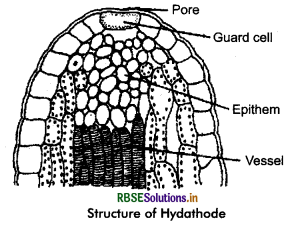
(b) Secretion: If an incision or wound is made in a stem, leaves or other part of plant, the latex oozes out, it is called secretion. In palm plant it occurs from phloem. In
Nerium, mango tree it occurs in the form of latex.
Long Answer Type Questions
Question 1.
What is osmosis? Demonstrate osmosis process with an experiment.
Answer:
Osmosis: A process in which two solutions of different concentrations are separated by a semi - permeable membrane, the diffusion of water or solvent molecules takes place from the solution of lower concentration to the solution of higher concentration. The process of osmosis is of two types:
1. Endosmosis: In the process of endosmosis, the water, or solvent molecules enter the cell from outer medium through cell membrane due to which the cell swells up. For example, when raisins are kept in water, they swell up due to endosmosis.
2. Exosmosis: In the process of exosmosis, the water or solvent molecules move from cell into the outer medium through cell membrane due to which the cell shrink. For example, when grapes are kept in concentrated salt solution, they shrink due to exosmosis.
Demonstration of Osmosis:
Egg Osmometer: Taking a chicken egg and remove the yolk and albumin through a small hole at one end of the egg. Place the shell in dilute solution of hydrochloric acid for a few hours. The egg shell dissolve leaving the membrane intact. Now tide this membrane with a glass tube through pore of membrane. Now fill this membrane with concentrated sugar solution. Now it is dipped in a beaker filled with water and fix on stand as shown in figure. After some time we observe that the level of solution in glass tube arises. It is clear that the process of endosmosis taken place through egg membrane.
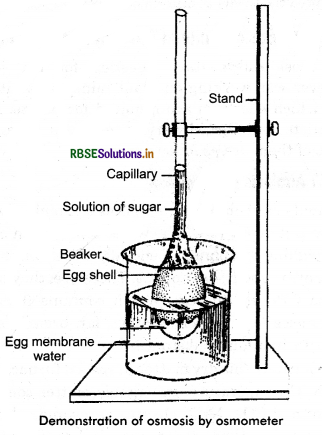
Question 2.
Differentiate between active transport and passive transport.
Answer:
Difference between Active Transport and Passive Transport
|
Active Transport |
Passive Transport |
|
1. It is a vital process. |
1. It is a physical process. |
|
2. Active transport, Usually takes |
2. It always takes place across concentration gradient. |
|
3. Active transport is normally unidirectional. |
3. Passive transport is usually bidirectional. |
|
4. The energy is required by cells in this transportation. |
4. The energy is not required by cells in this transportation. |
|
5. It is highly selective. |
5. It is not selective |
|
6. It helps in the accumulation of materials in the cells. |
6. It does not help in the accumulation of materials in the cells. |
|
7. This process is affected by metabolic inhibitors. |
7. This process is not affected by metabolic inhibitors. |
|
8. Active transport decreases with decrease in temperature. |
8. The decrease in temperature has no effect on passive transport. |
|
9. On decreasing the quantity of oxygen, the active transport either slows down or stops. |
9. It does not depend on the quantity of oxygen |
|
10. It requires carrier protein. The matrix or permease of the membrane does not take part in it. |
10. The carrier protein does not take part in it, passive transport takes place either by membrane matrix or permease. |
Question 3.
Write short notes on the following
(a) Ion exchange
(b) Donnan equilibrium
(c) Carrier concept
(d) Bennet - Clark’s protein lecithin theory
(e) Transportation of mineral ions.
Answer:
(a) Ion Exchange Theory: The mineral elements are absorbed by plant roots in the form of ions. These ions are absorbed on the surface of root hairs and they are exchanged by their own type of ions. This process is of two types:
(i) Contact Ion Exchange: According to this hypothesis, the absorbed ions are not tightly bound to the surface of root cells and soil particles, but oscillate within a small volume of space. If root and soil particles come very close to each - other and the oscillating ions on the root cell overlaps the oscillating ions on the soil particle, the direct exchange between them takes place i.e., without dissolving in soil solution. These ions enter the cell from the surface of root by diffusion.
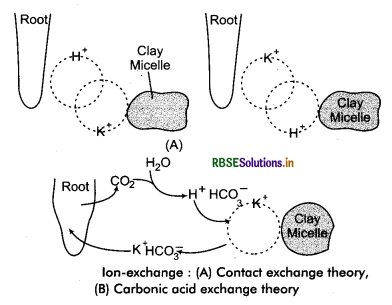
(ii) Carbonic Acid Exchange: The carbon dioxide released by root cells during respiration dissolves in soil water and forms carbonic acid (H2CO3). Carbonic acid, then dissociates into hydrogen ion (H +) and bicarbonate ion (HCO3). These ions can exchange with similar charged ions of soil solution as shown in above figure.
(b) Donnan's Equilibrium: The ions which cannot pass through cell membrane are called fixed ions or non - diffusible ions. These ions cannot be diffused outside the cell membrane, however, this membrane is permeable to anions (-ve) and cations (+ve) both present in the external medium.
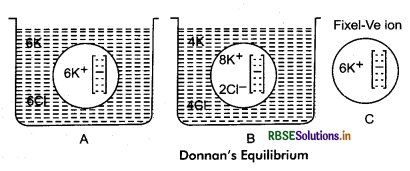
Suppose, some fixed ions are present in the cell and this cell is kept into a solution. Usually, both anions and cations will diffuse into the cell in equal number until an equilibrium between the cell sap and external solution is attained. But, for balancing fixed anions, more cations will diffuse into the cell that will balance the fixed anions present inside the cell. Hence, the concentration of cations in the cell will be more than the external solution. This balance or equilibrium is called Donnan equilibrium.
(c) Carrier Concept: According to this concept, plasma membrane is impermeable for free ions, but some chemical compounds are present on this membrane which function as ion - carriers. These carriers pickup ions from outer medium of the plasma membrane and form carrier - ion complexes.
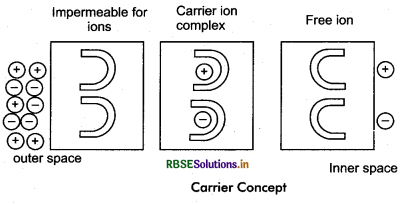
These complexes are capable of moving across the membrane. Therefore, these carrier ion complexes move into the inner space where they break down and release
ions. These ions once taken into the inner space cannot be return to outer space. The carrier compounds return to the outer space to repeat the process. The energy is required in this process to formation of carrier - ion complexes.
(d) Protein Lecithin Theory of Bennet Clark
Bennet and Clark (1956) described the presence of protein and phospho lipid in cell membrane. Where the proteins bound with lecithin (phosphotide). The phosphate group present between them binds +ve ions which release inside the membrane by the process of lacithinose. Lecithin resynthesises from phosphotidic acid and choline in the presence of choline acetylase.
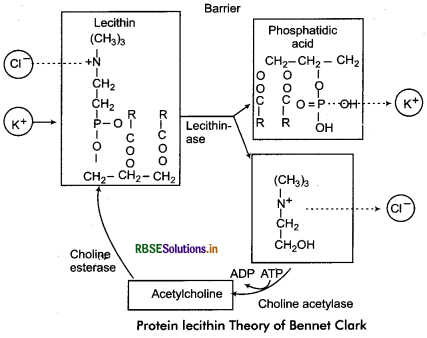
Note: Transport proteins of eniodermal cells are control points, when in a plant the quantity and types of solutes that reach the xylem tissue ions are absorbed by the plants by both active and passive transport. The further go up to all parts of plant through transpiration stream.
(e) It is believed that the ions absorbed by roots diffuse freely which reach to endodermis through epiblema and cortex and are finally released into xylem. Once, ions enter into xylem, they are translocated upward along with transpiration stream. The main sink for mineral elements is the area of plant growth such as shoot apex and lateral meristem, young leaves, developing flowers, fruits and seeds and storage organs. The immersion of mineral ions occurs due to diffusion and active uptake by the cells at last ends of thin veinnules. Mineral ions presently re - organised specially from senescing part. Old and perishing leaves export minerals present in them into newly forming leaves.
Exactly such a way the leaves before fall down from deciduous tree transfer their mineral elements to other part of the tree. The substances which usually rapid transferred are Phosphorus, sulphur, nitrogen and potassium. Some elements, which are structural factors such as calcium, they are not re-organised. The analysis of xylem secretion shows that some nitrogens are transported as inorganic ions. Likewise phosphorus and sulphur are also carried in the form of organic compounds. Beside this exchange of substances between xylem and phloem also occurs. Thus we unable to clear difference that xylem transports only inorganic nutrients and the phloem transports the organic nutrients as believed earlier.

Question 4.
What do you understand by Diffusion pressure deficit.
Or
Give relation between diffusion pressure deficit, osmotic pressure, turgor pressure and Wall pressure in a plant cell.
Answer:
1. Osmotic Pressure (OP): Osmotic pressure is a pressure which is applying on a solution from outside checks those osmosis of solvent, which occurs towards solution on separating that solution from its solvent by a semipermeable membrane. In other words, “the maximum pressure, which is developed in a solution, when it is separated from its pure solvent by a semipermable membrane, is Called osmotic pressure.” The osmotic pressure of a solution is directly proportional to the concentration of solute molecules present in the solvent. The osmotic pressure (OP) and the turgor pressure (TP) in a cell, both are created due to osmosis. In some substances, the osmotic pressure of water is always zero. The flow of water becomes always from lower osmotic concentration to higher osmotic concentration. The apparatus used for measuring osmosis is osmoscope or osmometer.
2. Turgor Pressure (TP): The plant cell has an outer rigid cell wall made of cellulose and inner plasma membrane. When a plant cell is kept in pure water, the water enters the cell by endosmosis because the osmotic concentration of cytoplasm of the cell is higher as a result of which, the pressure is exerted on the cytoplasm. This pressure increases with the entrance of water and exerts on the cellwall from inside towards outside. The pressure exerted by the cytoplasm against the cellwall is called turgor pressure. Such cell is called turgid cell and this state is called turgidity.
3. Wall Pressure: The cell wall is rigid and elastic and exerts pressure on the cytoplasm. The pressure exerted by cell wall on cytoplasm is called wall pressure. The cells remain turgid due to wall pressure and turgor pressure and the leaves wilt on reducing turgor pressure.
Question 5.
What is root pressure? Demonstrate root pressure with an experiment.
Answer:
Water a potted herbaceous plant. Keep it over night. Next morning, cut off the stem 7 - 8 cm above the soil level or near to the root. Fix a long and narrow glass tube to the cut and of the stump with the help of rubber tubing. This process should be done inside the water filled in a tube. It is because the air could not enter the tube and stump. Pour'a little coloured water in the glass tube and mark its level. The glass tube is connected to manometer and whole setup is the left for observation.
After some time the level of the coloured water rises in the tube. And rise in the level of the mercury of the monometer shows the measurement of root pressure. A rise in the level of water in the glass tube is due to the pressure exerted by water exuded from the the cut part of the stem. The exuding of water from the cut end of the stem is called bleeding. The flow of water from the cut surface or bleeding when measured by mercury manometer is estimated to 3 - 5 atm only.
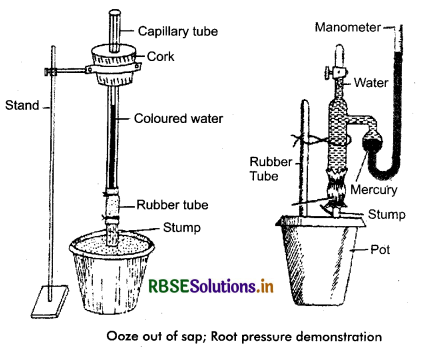
2. Vital force theory: To understand the mechanism of ascent of sap. Indian botanist sir J.C. Bose (1923) proposed the vital theory. It is also called Bose’s Pulsation Theory. He experimentally showed that the living cells of the inner most layer of the cortex were in state of pulsatory motion, i.e., alternate expansion and contraction. This pulsation, according to him, caused the pumping of water from cell to cell in an upward direction.
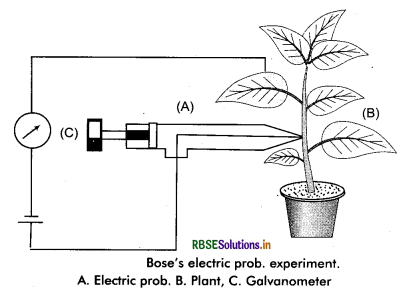
Bose experimented with a self-made apparatus, crescograph consisting of an electric probe, a galvanomenter, an electric dry cell, and a thin copper wire. He took a potted plant to which one point of the galvanometer was connected with a probe as shown in the figure. The probe was inserted into the stem slowly. When it reached the innermost layer of the cortex the galvanometer showed momentary deflection for a longer period. No such deflection was observed on either side of this particular layer. From this observation Bose concluded that the cells of this layer were in a state of pulsation. On expansion the cells absorbed water from the lower cells and on contraction water was pumped into the next higher cells. Bose also observed that for one pulsation (i.e., contraction and expansion) is took 14 seconds to several minutes. This pulsation was called by J.C. Bose as “heart - beating of plants”.
3. Physical force theory: According to this theory the process of ascent of sap takes place in only non - living cells. Many of scientists support this theory. This includes following principles :
(1) Capillary force theory: According to Boehm (1809), in the fine tube, the water rises as a result of surface tension to different heights depending on the capillarity of the tube. The finer the tube, the greater will be the rise of water in it. But the xylem vessels are some times broader than the capillarity range, and hence the rise due to surface tension will be negligible. Water can rise only up to height of one meter in xylem vessels having diameter of 0.03 mm. So this theory failed for tall plants.
(2) Imbibition theory: According to Sachs (1878), water moves upward in the xylem vessels due to imbibition. This theory is not accepted now because it is proved that water moves through the lumen of the xylem vessels and tracheids.
(3) Transpiration pull and Dixon's theory of cohesion: This is the most widely accepted theory put forth by Dixon and Joly in 1894 and further supported by Renner, curtic etc. It is also known as Dixon’s cohesion theory or Cohesion tension theory. According to this theory, the water rises upward in plants due to continuous transpiration and the column of water as vertical does not break. This theory depends on the following three assumptions:
(i) Transpiration Pull: Due to the transpiration from leaves, a great water deficit takes place in its cells. As a result of this deficit the water is drawn osmotically from the xylem cells in leaf veins, and by the cells surrounding the veins. Thus a sort of pull is produced in the uppermost xylem cells in the leaves. This pull is called as the transpiration pull. (It can be about 15 meters/hrs.)
(ii) Cohesive Force of Water: The water molecules have a great mutual attraction with each other or in other words we can say that they have tremendous cohesive power which is sometimes as much as 350 atm. Thus, the transpiration pull develops a negative pressure in the uppermost xylem cells. It is transmitted from there into the xylem of stems, and from there to roots.
(iii) Continuity of Water Column: The xylem vessels are connected with each other, thus the water in them is in a continuous column from the root hairs to the mesophyll cells of leaf, walls of trachieds and vessels of xylem are made up of lignin and cellulose and have strong affinity for water (adhesion). The cell wall of adjacent cells, and these between the cells and xylem vessels all through the plant do not affect the continuity of the water column.
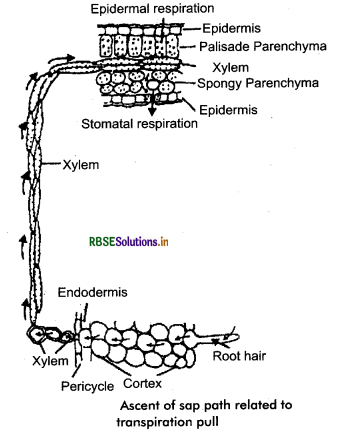
On this way the water rises due to the transpiration pull and the cohesive power of water molecules from the lowest part of the trees. The osmotic pressure in the transpiring leaf cells often reaches to 30 atm whereas only 20 atm are needed to raise the water to the tops of highest known trees.
Question 6.
What do you understand by transpiration? Explain bell jar experiment to demonstrate transpiration. Write the factors which affect transpiration.
Answer:
Transpiration:
Plants absorbs a huge amount of water from the soil by their roots. This water reaches to different parts of the plant by ascent of sap. The total amount of water absorbed by plant is more than their requirements. Only 1% friction of this water is utilised in their growth and development and huge amount of water is evaporated in the form of vapour through the aerial parts of plants. “The loss of water in the form of water vapour from the aerial parts of the plant is called transpiration” .
Demonstration of Transpiration:
The process of transpiration is demonstrated by bell jar method an easier experiment. For this we take a potted plant and water it properly. Now cover the pot with the help of polythene sheet or rubber sheet properly so that the water from pot does not evaporate. Then, place this pot under the belljar on a glass plate and make it air - tight with vaseline. After sometime, droplets of water will accumulate on the wall of belljar. This proves that vapours released from the leaves due to transpiration. After cooling is seen as droplets on the belljar.
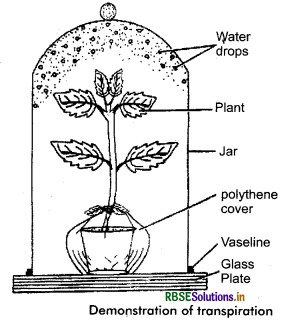
To find the Rate of Transpiration:
The rate of transpiration is affected by environmental conditions. Different environmental factors impact on transpiration directly or indirectly such as humidity of air, velocity of air, temperature, air pressure, available water etc.
Object: Demonstration of transpiration and study of different factors by Ganong’s potometer.
Required materials: Ganong’s potometer, a branch with leaves, a beaker, cork and cork borrer, wax, spirit lamp, water.
Procedure: Ganong’s potometer is fitted with water sinking it in a berken. Drill a cork and fit a twig in its hole. This cork with twig is now fixed in ganong’s potometer. Whole apparatus is made air - tight for this melted wax is coated. Then an air bubble is introduced in tube of ganong’s potometer through its open end. Now this apparatus is placed in environmental conditions.
Observation: The air bubble moves forward in horizontal tube of potometer which has the sign at distance. Displaced distance in relation to time is noted.
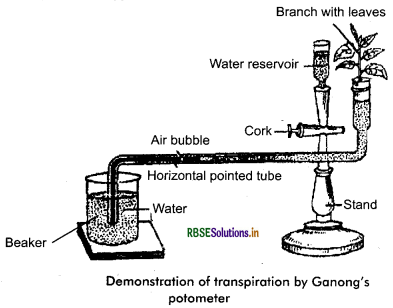
Conclusion: The water evaporates from leaves and other aerial parts of the twig which is fulfilled by tube of potometer. The horizontal tube of potometer pulls the water from beaker thereby the bubbles moves forward. The bubbles takes time for movement on scale, on the basis of this calculation, the rate of transpiration is concluded.
Study of Environmental Factors:
- If the apparatus placed under shady and moist condition, then transpiration will be minimum and the bubble will move less distance.
- If the apparatus placed under sunlight, then transpiration will be more.
- If the apparatus place under wind and sunlight, then transpiration will be maximum and the bubbles will move fast.
- If the apparatus placed under dark, then the bubbles will be not move.
Question 7.
Explain starch - sugar hypothesis for opening and closing of stomata.
Answer:
The stomata (sing : stoma) are most important main pathways found in leaves which are helpful in transpiration as well as gaseous exchange. The stomata may be defined as the simple small pores with regulatory mechanism situated on green parts, particularity on the surface of leaf. Each pore is surrounded by two kidney - shaped guard cells and it is called stoma. Guard cells are different from other cells. The inner wall of guard cells (towards pore) is thick and non - elastic and outer wall is thin and elastic. Each guard cell has a nucleus, numerous of mitochondria and chloroplast in protoplasm. However, micro fibrils subsidiary cells are also found around guard cells.
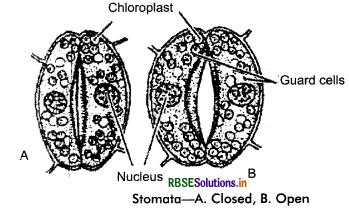
Distribution of Stomata: On the basis of distribution in leaves stomata are of the following five types:
- Apple and Mulberry type: In such type, stomata are present only on the lower surface of leaves, e. g., Apple, Mulberry etc. Such type of leaves are called hypostomatic.
- Potato Type: In such type, stomata are present on both the surfaces but more on the lower surface then upper surface, e.g., potato, tomato etc. Such type of leaves are called amphistomatic.
- Oat Type: In such type, stomata are almost present almost in equal number on both the surfaces, e.g., wheat, oat etc. Such type of leaves are called amphistomatic.
- Water Lily Type: In such type, stomata are present only on the upper surface, e.g., water lily, Nemphea etc. Such type of leaves are called epistomatic.
- Potamogeton Type: In such type, stomata are either absent or non - functional, e.g., Potamogeton and other submerged plants.
Question 8.
Explain the mechanism of water absorption.
Answer:
The absorption of water by plants is also called water uptake. Root hairs absorb capillary water from the soil. Absorption of water in plants takes place by two different methods:
- Active absorption of water
- Passive absorption of water
1. Active absorption of water:
Active absorption takes place in those plants which on having available amount of sufficient water in the soil, transpire less. In this type of absorption root takes an active parts and it is independent from any type of external pressure such as transpiration pull. In active absorption energy is required. This absorption is of two types:
A. Active absorption through osmotic mechanism:
This method of absorption is based on the general law of osmosis. Root acts as an osmometer in this absorption. According to law of osmosis, the water molecules move from their higher concentration to lower concentration. The osmotic pressure (OP) of cell sap of root hairs is more than osmotic pressure (OP) of solution in soil. Generally, the osmotic pressure of soil solution is less than 1 atm, whereas the osmotic pressure of cell sap of root hairs is about 2 - 8 atm. There is a large difference between the osmotic pressure of both the solutions. Hence, this soil water enters the root hair through endosmosis as a result of which the osmotic pressure of root hair is reduced because DPD =OP - TP. At this time, the DPD of adjacent cortical cells is higher than that of root hair. Therefore, the water diffuses into the adjacent cortical cells from root hair by the process of osmosis. The DPD of this cortical cell, after obtaining water becomes less than its other adjacent cells resulting into the diffusion of water from this cortical cell to other adjacent cells, such a way water moves from one cell to another and finally to endodermis by osmosis.
In endodermis infront of protoxylem, the passage cells or path cells without casparian strips are found. Thus the water finally reaches into xylem through these passage cells as a continuous column. The DPD of xylem cells is always higher than the cortical cells due to the accumulation of salts in them as a result of which the entry of water into them goes on.
Although the energy is not utilized directly in this process, however, metabolic energy is required for the absorption and accumulation of salts in the root cells which are essential for the maintenance of osmotic pressure in the root cells.
B. Active absorption through non - osmotic mechanism: In this method of water absorption, water is absorbed against osmotic gradient. In this process more energy is required. In this process water absorption takes place even when the osmotic pressure of soil water is more than the osmotic pressure of cell sap of root hair. Usually, under such conditions the diffusion of water molecules should take place from root hair to external solution, still the water absorption takes place against concentration gradient. For this type of absorption, the energy released from metabolic process is required. The utilization of energy may be direct or indirect.
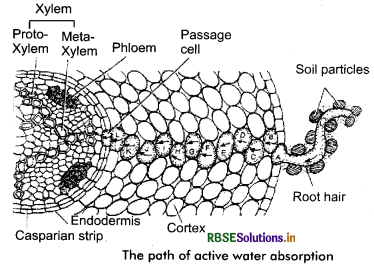
2. Passive Absorption:
It is the most common and intense method of water absorption, but it requires sufficient quantity of water in soil. It constitutes about 98% of the total water uptake by plant. In this process the absorption of water takes place not by roots but through roots i. e., roots takes part in passive form and act as only water carrier. In this method the energy is not required. In this type of water absorption, a force is developed in the aerial parts of plant due to transpiration pull that develops tension or high diffusion pressure deficit in the mesophyll cells of leaves. To reduce this DPD, the water enters the mesophyll cells from xylem cells of leaves.
A tension is developed in the xylem due to the continuous diffusion of water from xylem cells, which is transferred through petiole, branch, main stem and finally to xylem cells of roots. In this situation the DPD in the peripheral cells of young roots is increased. In roots DPD transfers from xylem cells to epidermal hairs whereby the diffusion of water takes place from root hairs to cortical cells due to which the osmotic concentration of cell sap of root hair increases. Since the concentration of soil solution is less than the cell sap of root hair, thereby the water enters into root hair. Such a way the root hairs absorb water from the soil due to the DPD of mesophyll and tension in xylem cells develops as a result of transpiration pull.

- RBSE Solutions for Class 11 Biology Chapter 10 Cell Cycle and Cell Division
- RBSE Solutions for Class 11 Biology Chapter 9 Biomolecules
- RBSE Solutions for Class 11 Biology Chapter 8 Cell: The Unit of Life
- RBSE Solutions for Class 11 Biology Chapter 7 Structural Organisation in Animals
- RBSE Solutions for Class 11 Biology Chapter 6 Anatomy of Flowering Plants
- RBSE Solutions for Class 11 Biology Chapter 5 Morphology of Flowering Plants
- RBSE Solutions for Class 11 Biology Chapter 4 Animal Kingdom
- RBSE Solutions for Class 11 Biology Chapter 3 Plant Kingdom
- RBSE Solutions for Class 11 Biology Chapter 2 Biological Classification
- RBSE Solutions for Class 11 Biology Chapter 1 The Living World
- RBSE Solutions for Class 11 Biology Chapter 5 पुष्पी पादपों की आकारिकी